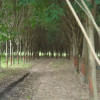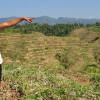March 2, 2024. I am standing in the middle of a thorough ruination of nature in Madhupur sal forest in Tangail. Planted around 30 years ago, monoculture of a single tree—rubber—is being cut down in hundreds, every day. The trees are felled, sectioned into pieces, loaded on trucks, and taken away immediately to be used as fuelwood, manufacture boards, burn bricks, and more. All that is left are stumps that may also soon be uprooted to prepare for the next rotation of rubber plantation. For some years, pineapple and other crops will grow with rubber trees as companion crops.
This has been happening for the last few weeks at Santoshpur and Pirgachha rubber gardens in Madhupur sal forest. Rubber, an exotic tree, has spread around the world from the Amazon rainforest. If rubber is commercially planted for latex, generally it has to be felled after 30-35 years. A rubber tree gives latex for around 26 years; then it becomes old and unproductive, and must be removed!
Cutting down rubber trees in two of the five gardens in Tangail-Sherpur rubber zone started last year, when 9,000 trees on 55 acres in Santoshpur and 7,000 trees on 55 acres in Pirgachha gardens were felled. In each of these two gardens, 12,375 rubber saplings had been planted. This year's target to cut unproductive rubber trees is 13,564 on 150 acres in Pirgachha and 25,900 on 150 acres in Santoshpur.

In Madhupur-Sherpur zone, there are five rubber gardens covering 8,128 acres of forestland managed by the state-owned Bangladesh Forest Industries Development Corporation (BFIDC), which has 14 more rubber gardens in other areas. Of these five gardens, four are in Madhupur sal forest on 7,503 acres of land.
The first rubber tree in Madhupur was planted on February 2, 1986. Then President HM Ershad flew to Madhupur in a helicopter to inaugurate a rubber plantation there. According to information from the BFIDC, since the first tree was planted almost four decades ago, a little over two million rubber saplings have been planted in the five gardens.
The Forest Department handed over the forestland to the BFIDC. The first thing BFIDC did to prepare the land for planting rubber saplings was clearing all of the natural vegetation—trees, shrubs, and undergrowth that harboured colonies of plant species, wildlife, birds, insects, bacteria—diverse forms of life.
Rubber plantation in Santoshpur preceded teak plantation, which replaced the natural forest. A local octogenarian from Mohishmara village named Hasmat Ali is a witness of the natural forest before teak was introduced in place of sal. "When I came to live here with my family 20 years before the Liberation War, this area had dense sal forest," he recalled. "I saw tigers, bears and deer in the forest. We had to be careful to protect our cattle from tigers. Then we saw sal forest auctioned and teak planted. Then came rubber during the time of Ershad."

Rubber came to Madhupur following its plantation in the Chittagong Hill Tracts (CHT). While finance for rubber plantation in the CHT came from the Asian Development Bank (ADB) and others, the first rubber plantation project in Madhupur was reportedly financed by the government itself.
However, for the second rubber plantation project in Madhupur, as well as in other areas, ADB almost completed the formalities for funding. Feasibility study was done and funds almost got into the pipeline. But in the face of severe criticism from different quarters, local resistance, and continued reporting by this author in the national press, ADB ultimately backed down from funding the project. Had the second project taken off, 15,000 more acres of forestland would have been converted to rubber plantation, leading to further devastation and more conflicts with the local communities. The first rubber plantation project had already caused lots of tension between the state agencies and the locals.
Local communities robbed of land, lifeline and livelihoods
It is because of rubber plantation in Madhupur that the local communities, including the ethnic Garos, have dramatically lost their access to forest produce and grazing land for their cattle. Rubber plantations are monoculture—nothing else grows on their floors. They may look green from a distance, but they are actually green deserts devoid of wildlife. When the leaves fall in January-March, the trees look completely burnt and barren. This is just the opposite of the natural forest.
Rubber plantation does not bode well for nature considering its ecological impacts on local communities, particularly ethnic minor communities.
According to the Bangladesh Rubber Board, as of now, around 140,000 acres of land has been devoted to rubber plantation across the country. Most of this land is state-owned. Rubber plantation was introduced on a smaller scale during Pakistan rule, but post-independence, it grew to a massive scale during the tenures of presidents Ziaur Rahman and Ershad. Owners of the rubber gardens include state agencies such as BFIDC, Bangladesh Rubber Board, and CHT Development Board, tea gardens, Bangladesh Tea Association, and private owners.
The most concerning and politically ill-motivated rubber plantation took place in the CHT region under private ownership on land much of which is customary to the Indigenous people in the region.

Vast areas of rubber gardens in Lama, Naikhognchhari, Bandarban Sadar and Alikadam upazilas of Bandarban district under private ownership has caused massive ecological disaster in the hills. According to district administration sources, around 45,000 acres of public land has been leased for commercial rubber production and horticulture in the district. The size of an individual plot is 25 acres. A government document provides a list of 1,635 individuals, proprietors and companies who have received plots for rubber planting and horticulture in these four upazilas. The leases were granted between 1980 and 1996. The list is an exposé of serious anomalies and a sinister government strategy. Of the 1,635 individuals, proprietors, and companies, only 32 are members of Indigenous communities. The majority of the leaseholders are Bangalees from other districts.
"Rubber plantation requires clearing of natural forest," says Goutam Dewan, chairman of the Chittagong Hill Tracts Citizens' Committee. "Overall, rubber has not just been successful in the CHT; it has caused massive disaster for ecology and Indigenous communities. It has been a factor behind the eviction of many Indigenous people from their customary land that they traditionally used for jhum cultivation and production of other crops."
Sources involved with the management of tea gardens say rubber plantation on land leased for tea production has not proven profitable. Now that the trees are mature, the fate of the land hangs in the balance.
Rubber, a colonial project
Rubber latex is indeed an amazing natural substance that we get from rubber trees. Rubber is a native species to the Amazon rainforest. The tree and its latex were unknown to Europe and Asia until Christopher Columbus brought it to Europe after his second voyage in 1493. Columbus called it caoutchouc, which means "the wood that weeps." In Asia, the British colonists brought rubber to Sri Lanka first, then to Malaya and gradually it spread to other countries, including Bangladesh. Asia now reportedly produces most of the world's natural rubber.
There was a time when humans could not think of life without goods made from natural rubber. Think of aeroplanes—could they take off in 1903 without wheels made of rubber? Most other vehicles required rubber. Despite the invention of synthetic rubber in 1931, natural rubber still remains in use in vehicles and indeed in thousands of other goods. All these rubber products have made our life easy and comfortable. It is undoubtedly a source of wealth that has brought prosperity to man. At some point, economies in Europe and North America were dependent on Brazilian rubber.
However, what is good for making man rich can be the cause of death to hundreds of other plants and animal species, including birds.
Natives of South America used to obtain milky latex from rubber trees by making incisions in the bark. Rubber has been in use for thousands of years in Latin America, dating back to as early as 1600 BCE. There was a "rubber people' during Olmec civilisation that lived in Mexico from around 1500 BCE to 400 BCE.
The Europeans went around the world, precisely to the Americas, in search of El Dorado (gold city) and minerals. They found some gold and silver by plundering cities and demolishing native civilisations. But they found more precious things—plants—rubber being the foremost among them. The Europeans and the colonists have benefited most from the exploitation of South America in particular. The colonialism may have ended, but the economic pillage has not and rubber still continues to give prosperity to the well-off in exchange for a very high ecological damage and miseries to the Indigenous people in particular.

Rubber, be it in the CHT, Madhupur or in the tea gardens, may bring some economic benefits to the state and private entrepreneurs, but in general it has not been beneficial to the people who once used these lands. Worse, rubber trees have depleted resources wherever they have been planted. Imagine the first rotation of all rubber trees which will have to be cut down in the next one decade or so, and presumably in most places rubber saplings will be planted again. This means what were forest patches three to four decades ago will disappear forever. Natural rubber thus becomes a death sentence to natural forests. There are indeed alternatives to natural rubber, and our strategy should be not to expand it any further. The government can also think of replacing rubber with native plants wherever possible.
Probin Chisim in Madhupur and Sylvester Tudu, an SEHD staff, assisted in the collation of some information from the field.
Philip Gain is researcher and director at the Society for Environment and Human Development (SEHD).
Views expressed in this article are the author's own.
Follow The Daily Star Opinion on Facebook for the latest opinions, commentaries and analyses by experts and professionals. To contribute your article or letter to The Daily Star Opinion, see our guidelines for submission.









Comments